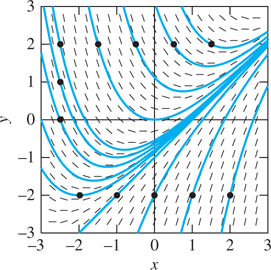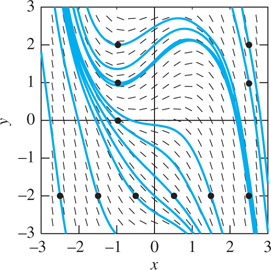 Section 1.3
by C. Henry Edwards,
David E. Penney,
David T. Calvis,
Differential Equations and Linear Algebra, 4th Edition
Section 1.3
by C. Henry Edwards,
David E. Penney,
David T. Calvis,
Differential Equations and Linear Algebra, 4th Edition
- Differential Equations & Linear Algebra
- Contents
- Application Modules
- Preface
- 1 First-Order Differential Equations
- 2 Mathematical Models and Numerical Methods
- 2.1 Population Models
- 2.2 Equilibrium Solutions and Stability
- 2.3 Acceleration–Velocity Models Acceleration–Velocity Models
- 2.4 Numerical Approximation: Euler’s Method Numerical Approximation: Euler’s Method
- 2.5 A Closer Look at the Euler Method
- An Improvement in Euler’s Method
- 2.6 The Runge–Kutta Method The Runge–Kutta Method
- 3 Linear Systems and Matrices
- 4 Vector Spaces
- 5 Higher-Order Linear Differential Equations
- 5.1 Introduction: Second-Order Linear Equations
- 5.2 General Solutions of Linear Equations
- 5.3 Homogeneous Equations with Constant Coefficients
- 5.4 Mechanical Vibrations
- 5.5 Nonhomogeneous Equations and Undetermined Coefficients
- 5.6 Forced Oscillations and Resonance
- 6 Eigenvalues and Eigenvectors
- 7 Linear Systems of Differential Equations
- 7.1 First-Order Systems and Applications
- 7.2 Matrices and Linear Systems
- 7.3 The Eigenvalue Method for Linear Systems
- 7.4 A Gallery of Solution Curves of Linear Systems
- Systems of Dimension n=2
- Real Eigenvalues
- Saddle Points
- Nodes: Sinks and Sources
- Zero Eigenvalues and Straight-Line Solutions
- Repeated Eigenvalues; Proper and Improper Nodes
- The Special Case of a Repeated Zero Eigenvalue
- Complex Conjugate Eigenvalues and Eigenvectors
- Pure Imaginary Eigenvalues: Centers and Elliptical Orbits
- Complex Eigenvalues: Spiral Sinks and Sources
- A 3-Dimensional Example
- 7.4 Problems
- 7.4 Application Dynamic Phase Plane Graphics
- 7.5 Second-Order Systems and Mechanical Applications*
- 7.6 Multiple Eigenvalue Solutions
- 7.7 Numerical Methods for Systems
- 7.7 Application Comets and Spacecraft
- 8 Matrix Exponential Methods
- 9 Nonlinear Systems and Phenomena
- 9.1 Stability and the Phase Plane
- 9.2 Linear and Almost Linear Systems
- 9.3 Ecological Models: Predators and Competitors
- 9.4 Nonlinear Mechanical Systems
- 10 Laplace Transform Methods
- 11 Power Series Methods
- References for Further Study
- APPENDIX A Existence and Uniqueness of Solutions
- APPENDIX B Theory of Determinants
- Answers to Selected Problems
- Index
Section 1.3
11. A unique solution exists in some neighborhood of
x=1 .12. A unique solution exists in some neighborhood of
x=1 .13. A unique solution exists in some neighborhood of
x=0 .14. Existence but not uniqueness is guaranteed in some neighborhood of
x=0 .15. Neither existence nor uniqueness is guaranteed in any neighborhood of
x=2 .16. A unique solution exists in some neighborhood of
x=2 .17. A unique solution exists in some neighborhood of
x=0 .18. Neither existence nor uniqueness is guaranteed.
19. A unique solution exists in some neighborhood of
x=0 .20. A unique solution exists in some neighborhood of
x=0 .21. Your figure should suggest that
y(−4)≈3 ; an exact solution of the differential equation givesy(−4)=3+e−4≈3.0183 .
22.
y(−4)≈−3 23. Your figure should suggest that
y(2)≈1 ; the actual value is closer to 1.004.
24.
y(2)≈1.5 25. Your figure should suggest that the limiting velocity is about 20 ft/sec (quite survivable) and that the time required to reach 19 ft/sec is a little less than 2 seconds. An exact solution gives
v(t)=19 whent=58ln 20≈1.8723 .
26. A figure suggests that there are 40 deer after about 60 months; a more accurate value is
t≈61.61 . The limiting population is 75 deer.27. The initial value problem
y'=2y√, y(0)=b has no solution ifb<0 ; a unique solution ifb>0 ; infinitely many solutions ifb=0 .
28. The initial value problem
xy'=y, y(a)=b has a unique solution ifa≠0 ; infinitely many solutions ifa=b=0 ; no solution ifa=0 butb≠0 .29. The initial value problem
y'=3y2/3, y(a)=b always has infinitely many solutions defined for all x. However, ifb≠0 then it has a unique solution nearx=a .
30. The initial value problem
y'=−1−y2−−−−−√, y(a)=b has a unique solution if|b|<1 ; no solution if|b|>1 , and infinitely many solutions (defined for all x) ifb=±1 .31. The initial value problem
y'=1−y2−−−−−√, y(a)=b has a unique solution if|b|<1 ; no solution if|b|>1 , and infinitely many solutions (defined for all x) ifb=±1 .
32. The initial value problem
y'=4xy√, y(a)=b has infinitely many solutions (defined for all x) ifb≧0; no solutions ifb<0 . However, ifb>0 then it has a unique solution nearx=a .33. The initial value problem
x2y'+y2=0, y(a)=b has a unique solution with initial point (a, b) ifa≠0 , no solution ifa=0 butb≠0 , infinitely many solutions ifa=b=0 .
34. (a) If
y(−1)=−1.2 theny(1)≈−0.48 . Ify(−1)=−0.8 theny(1)≈2.48 . (b) Ify(−3)=−3.01 theny(3)≈−1.0343 .If
y(−3)=−2.99 theny(3)≈7.0343 .35. (a) If
y(−3)=−0.2 theny(2)≈2.019 . Ify(−3)=+0.2 theny(2)≈2.022 . In either case,y(2)≈2.02 . (b) Ify(−3)≈−0.5 theny(2)≈2.017 . Ify(−3)≈+0.5 theny(2)≈2.024 . In either case,y(2)≈2.02 .
-
No Comment









